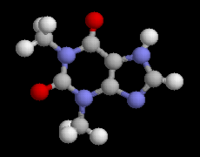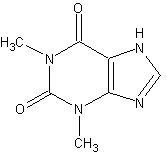EVIDENCE-BASED ANSWER with adults, oral theophylline may help lower the dosage of inhaled steroids needed to control chronic asthma. It offers no benefit for acute asthma exacerbations. For children, intravenous aminophylline may improve the clinical course of severe asthma attacks. Side effects and toxicity limit use of these medications in most settings. (Grade of recommendation: A, based on systematic reviews and randomized control trials [RCTs]).
EVIDENCE SUMMARY Several systematic reviews help clarify theophylline's role in asthma management. When compared with placebo in the management of acute exacerbations, theophylline confers no added benefit to beta-agonist therapy (with or without steroids) in improving pulmonary function or reducing hospitalization rates. Side effects occurred more often in the theophylline group: palpitations/arrhythmias (OR = 2.9; 95% CI: 1.5 to 5.7) and vomiting (OR = 4.2; 95% CI: 2.4 to 7.4). (1) For moderately severe asthma in patients already receiving inhaled corticosteroids (ICS), theophylline as maintenance therapy equaled long-acting beta-2-agonists in increasing FE[V.sub.1] and PEFR, but was less effective in controlling night time symptoms. Use of long-acting beta-agonists resulted in fewer side effects (RR = 0.38; 95%CI: 0.25-0.57). (2) When added to low-dose ICS for maintenance, theophylline was as effective as high-dose ICS alone in improving FE[V.sub.1], decreasing day and night symptoms, and reducing the need for rescue medications and the incidence of attacks. This suggests theophylline has utility as a steroid sparing agent. (3)
Intravenous aminophylline does appear to be clinically beneficial for children with severe exacerbations, defined as an FE[V.sub.1] of 35%-40% of predicted value. Critically ill children receiving aminophylline in addition to usual care exhibited an improved FE[V.sub.1] at 24 hours (mean difference = 8.4%; 95% CI: 0.82 to 15.92) and reduced symptom scores at 6 hours: (4) The largest RCT of aminophylline in children demonstrated a reduced intubation rate (NNT = 14 CI: 7.8-77). (5) Children receiving aminophylline experienced more vomiting (RR = 3.69; 95%CI: 2.15-6.33). Treatment with aminophylline did not reduce length of hospital stay or the number of rescue nebulizers needed (Table). (4)
RECOMMENDATIONS FROM OTHERS Three evidence-supported guidelines concur that theophylline has a limited role as maintenance therapy for moderate-to-severe persistent asthma when symptom control with ICS alone is not adequate. Much stronger evidence supports the use of long-acting beta-2-agonists or leukotriene modifiers in this setting. (6-8) The guidelines do not recommend using theophylline to treat acute asthma exacerbations; nor do they address using theophylline in children.
REFERENCES
(1.) Wilson AJ, Gibson, PG, Coughlan J. The Cochrane Library, Issue 2, 2002 Oxford: Update Software.
(2.) Parameswaran K, Belda J, Rowe BH. The Cochrane Library, Issue 2. 2002, Oxford: Update Software.
(3.) Evans DJ, Taylor DA, Zetterstrom O, et al. N Engl J Med. 1997; 337:1412-8.
(4.) Mitra A, Bassler D, Ducharme FM. The Cochrane Library, Issue 2, 2002, Oxford: Update Software.
(5.) Yung M, South M. Arch Dis Child 1998;79: 405-410.
(6.) Management of Chronic Asthma. Evidence Report/Technology Assessment Number 44. AHQR Publication Number 01-E043, September 2001.
(7.) Global Initiative for Asthma, National Heart, Lung and Blood Institute, (U.S.)/World Health Organization 1995 Jan (revised 1998).
(8.) Expert Panel Report 2:Guidelines for the diagnosis and management of asthma. National Asthma Education and Prevention Program/National Heart, Lung and Blood Institute (U.S.), 1997 Jul, (reprinted 1998 Apr, 1999 Mar).
Read a Clinical Commentary by M. Lee Chambliss, MD, MSPH, at www.fpin.org.
COPYRIGHT 2002 Dowden Health Media, Inc.
COPYRIGHT 2002 Gale Group



